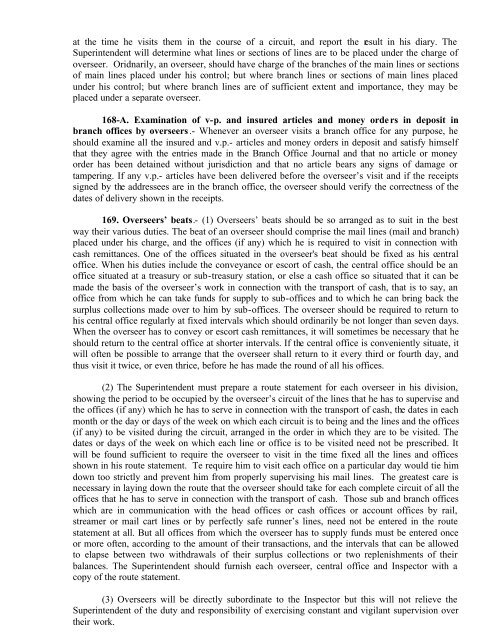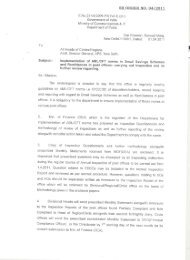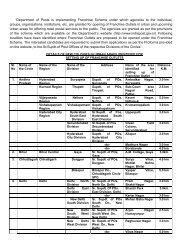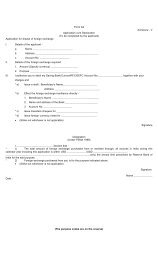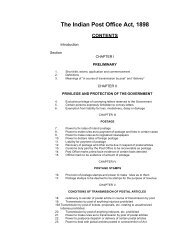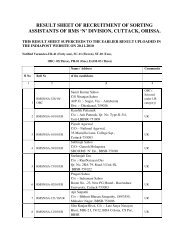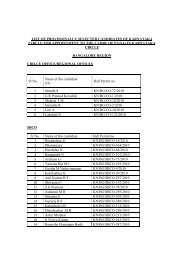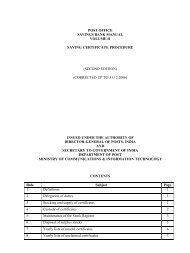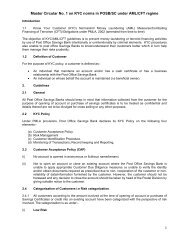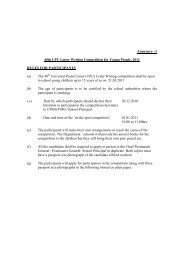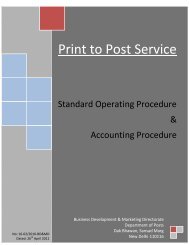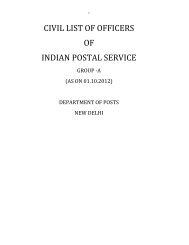Postal Manual Vol. VIII - India Post
Postal Manual Vol. VIII - India Post
Postal Manual Vol. VIII - India Post
You also want an ePaper? Increase the reach of your titles
YUMPU automatically turns print PDFs into web optimized ePapers that Google loves.
at the time he visits them in the course of a circuit, and report the result in his diary. The<br />
Superintendent will determine what lines or sections of lines are to be placed under the charge of<br />
overseer. Oridnarily, an overseer, should have charge of the branches of the main lines or sections<br />
of main lines placed under his control; but where branch lines or sections of main lines placed<br />
under his control; but where branch lines are of sufficient extent and importance, they may be<br />
placed under a separate overseer.<br />
168-A. Examination of v-p. and insured articles and money orders in deposit in<br />
branch offices by overseers.- Whenever an overseer visits a branch office for any purpose, he<br />
should examine all the insured and v.p.- articles and money orders in deposit and satisfy himself<br />
that they agree with the entries made in the Branch Office Journal and that no article or money<br />
order has been detained without jurisdiction and that no article bears any signs of damage or<br />
tampering. If any v.p.- articles have been delivered before the overseer’s visit and if the receipts<br />
signed by the addressees are in the branch office, the overseer should verify the correctness of the<br />
dates of delivery shown in the receipts.<br />
169. Overseers’ beats.- (1) Overseers’ beats should be so arranged as to suit in the best<br />
way their various duties. The beat of an overseer should comprise the mail lines (mail and branch)<br />
placed under his charge, and the offices (if any) which he is required to visit in connection with<br />
cash remittances. One of the offices situated in the overseer's beat should be fixed as his central<br />
office. When his duties include the conveyance or escort of cash, the central office should be an<br />
office situated at a treasury or sub-treasury station, or else a cash office so situated that it can be<br />
made the basis of the overseer’s work in connection with the transport of cash, that is to say, an<br />
office from which he can take funds for supply to sub-offices and to which he can bring back the<br />
surplus collections made over to him by sub-offices. The overseer should be required to return to<br />
his central office regularly at fixed intervals which should ordinarily be not longer than seven days.<br />
When the overseer has to convey or escort cash remittances, it will sometimes be necessary that he<br />
should return to the central office at shorter intervals. If the central office is conveniently situate, it<br />
will often be possible to arrange that the overseer shall return to it every third or fourth day, and<br />
thus visit it twice, or even thrice, before he has made the round of all his offices.<br />
(2) The Superintendent must prepare a route statement for each overseer in his division,<br />
showing the period to be occupied by the overseer’s circuit of the lines that he has to supervise and<br />
the offices (if any) which he has to serve in connection with the transport of cash, the dates in each<br />
month or the day or days of the week on which each circuit is to being and the lines and the offices<br />
(if any) to be visited during the circuit, arranged in the order in which they are to be visited. The<br />
dates or days of the week on which each line or office is to be visited need not be prescribed. It<br />
will be found sufficient to require the overseer to visit in the time fixed all the lines and offices<br />
shown in his route statement. Te require him to visit each office on a particular day would tie him<br />
down too strictly and prevent him from properly supervising his mail lines. The greatest care is<br />
necessary in laying down the route that the overseer should take for each complete circuit of all the<br />
offices that he has to serve in connection with the transport of cash. Those sub and branch offices<br />
which are in communication with the head offices or cash offices or account offices by rail,<br />
streamer or mail cart lines or by perfectly safe runner’s lines, need not be entered in the route<br />
statement at all. But all offices from which the overseer has to supply funds must be entered once<br />
or more often, according to the amount of their transactions, and the intervals that can be allowed<br />
to elapse between two withdrawals of their surplus collections or two replenishments of their<br />
balances. The Superintendent should furnish each overseer, central office and Inspector with a<br />
copy of the route statement.<br />
(3) Overseers will be directly subordinate to the Inspector but this will not relieve the<br />
Superintendent of the duty and responsibility of exercising constant and vigilant supervision over<br />
their work.


